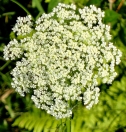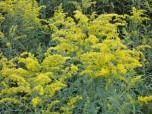Native Americans and colonists used Monarda as a medicinal plant, for example using M. punctata to cure colic.
They also made Oswego tea from the M. fistulosa’s leaves and flowers. I’ve tried it and conclude it is either an acquired taste or the bitter pill for what ails you — while not horrible, certainly an unusual fragrance and taste. According to Edwin Rollin Spencer’s All About Weeds (Dover Publications, 1968, page 218) the Monarda name was given in 1574 by Nicolas Monardes, who never visited the New World, but as a doctor in France, worked on the medicinal properties of these plants. You can search the Internet to find how Mondarda was, and is still, used as a cure for many respiratory complaints. Recipes for tea are available.I do enjoy all the wildflowers that inhabit my property. They create color interest in the wild areas and offer me the challenge of discovering information about them. Of the many problem of a country garden, one of the most difficult is how to successful move from the cultivated landscape into the wild without a sharp distinction. Another problem is researching what is a wildflower from an invasive species, and to encourage the right one. The Internet has made this process increasingly easy. State DNR offices and environmental groups offer other assets. At a recent garden club meeting I received a copy of A Field Identification Guide to Invasive Plants in Michigan’s Natural Communities. I thought I knew a lot, but I was certainly deluding myself. One invasive plant is Centaurea stoebe or spotted knapweed, which could easily be confused with M. fistulosa.
That said, wildflowers help make that transition from garden to wild, and in summer and fall Monarda and Solidago (goldenrod) can do a spectacular job at this. In this endeavor I am also introducing other native wildflowers like coneflowers and black-eyed susans into my surrounding field. Since these already grown in my garden, it should help blend garden and wild.






































2 comments
Comments feed for this article
July 30, 2012 at 10:29 am
Stan
Hi,
My name is Stan Mattson and my wife Pennie and I live outside of Cadillac. I stumbled unto uor sitr looking for a local floral club. I have some Indian Pipe or ghost flower sprouting on the property abd thought if there was some very serious wildflower people that hadn’t seen them I would offer them the opportunity. I believe the Latin name is Monotropa Uniflora.
Stan
July 30, 2012 at 11:47 am
rhobinlee
It is hard to get garden club members together on short notice because they operate on a year-book schedule. However, I would certainly be interested in seeing them if you aren’t too far away from where I live (27 mile SW of Cadillac). For privacy you can contact me at email rhobinlee at yahoo dot com.